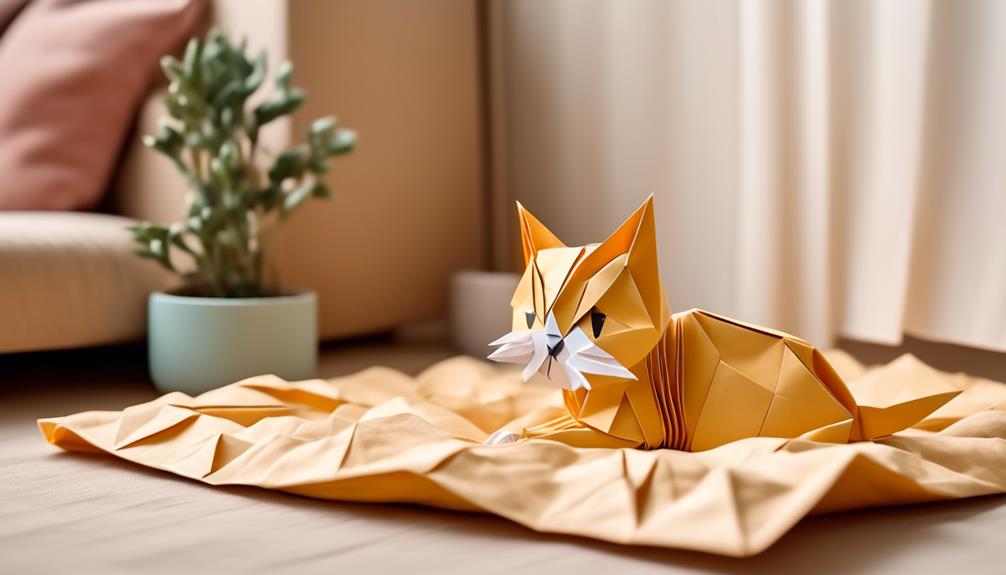Your beloved cat, once an unstoppable force of agile grace, seems to have slowed down to a crawl, showing signs that every step might be a silent battle with joint pain. It’s heartbreaking to see your older cat not leap with the same effortless joy they once had, and you’re likely wondering what’s at the root of this change.
Arthritis, a common thief of mobility in aging cats, could be silently weaving its way through your pet’s joints. This condition isn’t just a simple side effect of aging; it’s a complex interplay of wear and tear, past injuries, and possibly even genetic factors.
If your cat seems cautious in its movements, it’s essential to identify arthritis signs, understand its causes, and learn how to support your cat through this challenging time.
Key Takeaways
- Arthritis is a common condition in older cats, caused by age-related joint wear and cartilage breakdown.
- Diagnosing feline arthritis requires a thorough physical exam, X-rays to assess joint condition, and understanding behavior and pain through questionnaires.
- Symptoms of feline arthritis include reluctance to leap or climb, decreased activity, irritability when petted or handled, and variations in grooming habits.
- Treatment options for feline arthritis include nutritional support, advanced therapies like acupuncture and laser therapy, adaptation of the environment, and tailoring treatment to each cat’s unique needs.
Recognizing Arthritis Symptoms
If you notice your cat moving with a bit more caution or reluctance, it may be a sign of arthritis setting in. This condition, known as arthritis in cats or Cats with OA (osteoarthritis), isn’t just a human ailment; our feline friends can suffer too. You might see subtle changes such as hesitancy to jump or climb, perhaps even stiffness in their legs. These physical exam findings are vital clues indicating possible joint problems.
As someone who deeply cares for the wellbeing of animals, it’s essential to observe your cat’s behavior for signs of pain. A decrease in their usual activities, altered sleep patterns, and a decline in grooming habits could all point to discomfort due to pain and inflammation in their joints. Cats are stoic creatures, often hiding their pain, so you may also notice them seeking solitude, which can be a cry for help in their silent world.
If your cat shows any aggression during petting, it’s not out of character; it might be a reaction to the pain they’re experiencing. Weight loss and difficulty jumping are also red flags. Remember, your gentle vigilance can make a world of difference in managing your beloved cat’s comfort and health.
Understanding Arthritis Causes
You might notice your older cat isn’t as spry as they once were, and it’s heartbreaking to see them in discomfort.
Arthritis, often due to age-related wear on their joints, can steal their agility and zest.
It’s important to understand that inflammatory conditions also play a role, and these can impact your cat’s quality of life.
As cats age, their joints often bear the brunt of years of wear and tear, leading to conditions like osteoarthritis that can greatly affect their quality of life. This age-related joint wear, or degenerative joint disease, is unfortunately common in older cats.
Here’s how it unfolds:
- Cartilage Breakdown: The smooth cartilage that cushions joint movements deteriorates, causing bones to rub painfully against each other.
- Inflammatory Response: The body’s natural reaction to this wear and tear can lead to chronic inflammation, exacerbating arthritis.
- Decreased Mobility: As the pain sets in, your once sprightly cat may move less, jump with hesitation, or stop grooming regularly.
Your devotion to your cat drives the search for comfort and relief, ensuring their golden years are filled with the warmth and care they deserve.
Inflammatory Conditions Impact
Understanding that your beloved cat’s arthritis stems from inflammation can help you seek the most effective treatments to ease their discomfort. Arthritis, particularly osteoarthritis, is a chronic condition affecting many older cats. It’s heartbreaking to see them suffer from joint pain as they move less freely than they once did.
The inflammatory conditions impact your cat’s quality of life, but there’s hope. Pain relief is possible through the use of anti-inflammatory drugs, commonly known as nonsteroidal anti-inflammatory drugs (NSAIDs), which can greatly improve their comfort. It’s important to approach their care with compassion, ensuring they receive the necessary treatments to live their golden years with as little pain as possible.
Always consult a vet for the best course of action to help your cat.
Diagnosing feline Arthritis
You’ve noticed your older cat isn’t as spry as they once were, and you’re concerned it might be arthritis.
It’s important to visit your vet, who can conduct a thorough physical exam and may suggest X-rays to see what’s happening with your cat’s joints.
Detecting arthritis early can make a world of difference in managing your cat’s comfort and mobility.
Identifying Arthritis Symptoms
Spotting the subtle signs of arthritis in your beloved cat, like a reluctance to leap onto their favorite perch, can be the first clue to their joint discomfort. As a caretaker, it’s heart-wrenching to see your senior cat affected by OA, as arthritis can cause painful joints.
They often hide their pain, so look for these changes:
- A decrease in activity, such as playing less or no longer using the cat tree.
- Altered behavior, perhaps becoming irritable when petted or handled.
- Variations in grooming habits, either over-grooming sore spots or neglecting to groom because of joint pain.
Your empathy and vigilance are vital in recognizing these symptoms early, offering your cat the best chance for a comfortable life.
Veterinary Diagnostic Methods
If your cat becomes less active, take them to the vet to check for arthritis with various tests. The vet will examine the cat carefully for joint swelling and pain, knowing early detection is vital for treatment.
Radiographs are a window into your cat’s body, revealing any cartilage deterioration or abnormal development, akin to hip dysplasia, a disease in dogs. The vet may also analyze joint fluid, a significant step in confirming arthritis.
Here’s a snapshot of the diagnostic tools your vet might use:
| Diagnostic Method | Purpose | Notes |
|---|---|---|
| Physical Exam | Assess mobility and joint pain | Gentle palpation |
| Radiographs | Visualize joint condition | May show cartilage deterioration |
| Questionnaires | Understand behavior and pain at home | Helps tailor treatment |
Treatment Options Explored
Exploring treatment options can ease your older cat’s joint pain and enhance their quality of life. It’s heart-wrenching to see a beloved cat in discomfort, when conditions like arthritis or hip dysplasia are the culprits. But remember, you’re not powerless in this situation. There are effective ways to alleviate their pain and help them live more comfortably.
Here are a few compassionate steps you can take:
- Integrate Nutritional Support: Prescription diets like Hills J/D are formulated to bolster joint health, while supplements rich in fatty acids, such as fish oils, may help repair and replenish cartilage. This can be a game-changer in managing arthritis.
- Consider Advanced Therapies: Acupuncture and laser therapy have shown promise in providing pain relief and improving mobility. These treatment options can be gentle yet effective in reducing joint pain and inflammation.
- Adapt Their Environment: Small changes in your home, such as providing ramps for easier access to favorite perches or laying out soft bedding, can offer your cat the comfort they deserve and improve their day-to-day mobility.
Each cat is unique, so it’s important to work closely with your vet to tailor the treatment plan to your cat’s specific needs.
Home Care Strategies
Caring for your aging cat at home involves creating a supportive environment that caters to their comfort and eases the stress on their aching joints. Joint pain, particularly from osteoarthritis (OA), can impact your beloved cat’s quality of life. However, with thoughtful home care strategies, you can help your cat live more comfortably.
Start by providing a warm, cozy bed that cradles their body and soothes the pain associated with OA. A little extra padding can go a long way in offering relief. Gentle joint massages can also help by increasing circulation and mobility, but be sure to approach this softly to avoid any discomfort.
Help with grooming, especially in difficult areas, to maintain your cat’s cleanliness without causing strain on their sore joints. Also, make sure their litter box is in a place that’s easy to get to and doesn’t force them to use stairs, as this can cause them pain.
Dietary Adjustments Needed
To alleviate your older cat’s joint pain, consider incorporating specific dietary changes that target joint health and weight management. It’s essential to understand that joint pain, which can be due to arthritis or hip dysplasia, may be soothed with the right nutrition, and you can help your beloved cat by making these dietary adjustments needed for their well-being.
Here are a few steps to guide you:
- Weight Management: Help your cat maintain a healthy weight through portion control and a low-calorie diet. Excess weight can exacerbate joint pain by increasing the strain on their joints.
- Nutrient-Rich Diet: Include ingredients rich in joint-supporting nutrients such as glucosamine and omega-3 fatty acids. These can help reduce inflammation and promote healthier joints.
- Accessibility: Ensure that food and water dishes are easily accessible. Minimizing the need for your cat to jump or climb can reduce stress on their aching joints.
Professional Vet Interventions
When your cat starts showing signs of joint pain, it’s important to consult with a veterinarian who can pinpoint the issue and tailor a treatment plan to your pet’s specific needs. Cats over the age where arthritis and hip dysplasia become concerns require special attention.
Your vet will likely use X-rays and a thorough physical exam to visualize the extent of cartilage deterioration and evaluate the mobility, swelling, and pain in your cat’s joints.
Professional vet interventions for joint pain in cats may include several options. Acupuncture and laser therapy are innovative treatments that can reduce discomfort and inflammation. Prescription diets, specifically formulated to support joint health, along with pain medications and nutritional supplements, can also be prescribed to manage symptoms and improve quality of life.
Weight management is a non-drug option that your vet might recommend to ease the strain on your cat’s joints. Gentle, increased exercise and modifications to your cat’s environment can help maintain mobility and comfort.
If needed, veterinary nonsteroidal anti-inflammatory drugs (NSAIDs) or other pain management medications may be prescribed to help alleviate your cat’s joint pain and restore their zest for life.
Frequently Asked Questions
How Do You Help a Senior Cat With Arthritis?
To help your senior cat with arthritis, provide a cozy bed, give gentle massages, place essentials on one floor, assist with grooming, and ensure the litter box is easily accessible for comfort.
At What Age Do Cats Start Having Joint Problems?
You’ll notice cats can start having joint issues around 7 to 10 years old, if they’re larger breeds or have had past injuries. It’s key to keep them comfortable as they age.
How Long Do Cats With Arthritis Live?
Your adored cat with arthritis could potentially bask in the golden years for quite some time with tender, loving care and regular vet visits to fine-tune their comfort and well-being.
Why Is My Older Cat Having a Hard Time Walking?
Your older cat’s difficulty walking likely stems from joint discomfort, often due to age-related changes. Gentle care and vet-recommended treatments can ease their movement and improve their quality of life.di




